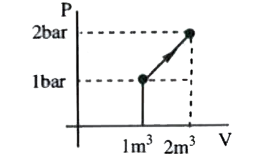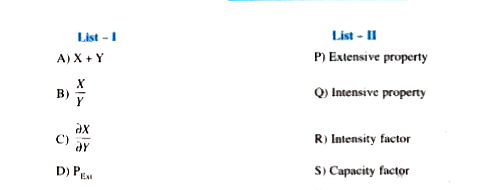Complete Solutions to Practice Sheet-Exercise-I of chapter CHEMICAL THERMODYNAMICS of Class 12 book with complete answers and questions
| Class 12 | CHEMISTRY |
| Chapter | CHEMICAL THERMODYNAMICS |
| AAKASH SERIES | Practice Sheet-Exercise-I |
| Number Of Questions | 33 |
| Academic Year | 2023-24 |
Which of the following diagram correctly represents the variation of internal energy (U) of gas under expansion at constant temperature.
View SolutionOne mole of an ideal monoatomic gas expands isothermally against constant external pressure of 1 atm from initial volume of 1l to a state where its final pressure becomes equal to external pressure. If initial temperature of gas is 300K then total entropy change of system in the above process is: [R =0.082L atm `mol^(-1)K^(-1)= 8.3J mol^(-1) K^(-1)`]
View SolutionThe magnitudes of enthalpy changes for irreversible adiabatic expansion of a gas from 1L to 2L is `∆H_(1)` and for reversible adiabatic expansion for the same expansion is `∆H_(2)`. Then
View SolutionA sample of gas is compressed from an initial volume of `2v_(0) " to " v_(0)` using three different processes.
First: Using reversible isothermal
Second: Using reversible adiabatic
Third: Using irreversible adiabatic under a constant external pressure then
View SolutionOne mole of an ideal monoatomic gas at temperature T and volume 1L expands to 2L against a constant external pressure of one atm under adiabatic conditions, then final temperature of gas will be:
View SolutionWhich has maximum internal energy at 298K?
View SolutionA heat engine absorbs heat `q_(1)` from a source at temperature `T_(1)` and heat `q_(2)` from a source at temperature `T_(2)`. Work done is found to be `J (q_(1) + q_(2))`. This is in accordance with
View SolutionAssertion: An isothermal process is always an isolated one.
Reason: During an isothermal change, there exists thermal equlibrium between system and surroundings.
View SolutionWhat is DU for the process described by figure. Heat supplied during the process q=100kJ.

View Solution6 what is the change in internal energy when a gas contracts from 377 ml to 177 ml under a constant pressure of 1520 torr, while at the same time being cooled by removing 124 J heat? [Take (1 L atm)= 100J]
View SolutionThe heat capacity of liquid water is 75.6 J/mol K, while the enthalpy of fusion of ice is 6.0 kJ/mol. What is the smallest number of ice cubes at `0^(@)C`, each containing 9.0g of water, needed to cool 500g of liquid water from `20^(@)C " to " 0^(@0C`?
View SolutionStatement -I : There is no change in enthalpy of an ideal gas during compression at constant temperature.
Statement-II: Enthalpy of an ideal gas is a function of temperature and pressure.
View SolutionMolar heat capacity of water in equilibrium with ice at constant pressure is:
View SolutionWhich of the following statements is false?
View SolutionOn which of the following factors does internal energy depend upon
View SolutionThe enthalpy is maximum for
View SolutionThe different between `DeltaH and DeltaE` for the reaction `BaCl_(2(aq)) + K_(2)SO_(4(aq)) rarr BaSO_(4(s)) darr +2KCl_((aq))`
View SolutionFor the gaseous reaction involving the complete combustion of isobutane
View SolutionDuring a process work equivalent to 400J is done on a system, which gives out of 125J of energy. The change in internal energy is
View SolutionA system absorbs 10kJ of heat at constant volume and its temperature rises from `27^(0)C " to " 37^(0)C`. The DE of reaction is
View SolutionWhich of the following come under the view of thermodynamics?
View SolutionDuring expansion of a gas into vaccum `(P_("ext")=0)`, Work done is zero if the process is
(A) Reversible (B) Irreversible (C ) Isothermal
View SolutionIn the isothermal expansion of an ideal gas
View SolutionWhich has/have a positive value of `DeltaH`?
View SolutionThe following is/are extensive property/properties
View SolutionIf the boundary of system moves by an infinitesimal amount, the work involved is given by `dw= -P_("ext") dV`, for irreversible process `W= -P_("ext") Delta V` (where `Delta V= V_(f) - V_(i)`). For reversible process. `P_("ext") = P_("int") +- dP ~= P_("int")`, so for reversible isothermal process `W = -nRT "In" (V_(f))/(V_(i))`
2 mole of an ideal gas undergoes isothermal compression along three different paths:
(i) reversible compression from `P_(i) = 2` bar and `V_(i) = 8L " to" P_(f) = 20` bar
(ii) a single stage compression against a constant external pressure of 20 bar
(iii) a two stage compression consisting initially of compression against a constant external pressure of 10 bar until `P_("gas") = P_("ext")`, followed by compression aganist a constant pressure of 20 bar until `P_("gas") = P_("ext")`
Work done (in bar -L) on the gas in reversible isothermal compression is:
View SolutionIf the boundary of system moves by an infinitiesimal amount, the work involved is given by `dw= -P_("ext")` dV, for irreversible process `W= -P_("ext") Delta V` (where `DeltaV= V_(f)- V_(i)`). For reversible process `P_("ext") = P_("int") +- dP ~~ P_("int")`, so for reversible isothermal process `W= -nRT`ln `(V_(f))/(V_(i))`. 2 mole of an ideal gas undergoes isothermal compression along three different paths:
(i) reversible compression from `P_(i)= 2` bar and `V_(i)= 8` to `P_(f)=20` bar
(ii) a single stage compression against a constant external pressure of 20 bar
(iii) a two stage compression consisting initially of compression against a constant external pressure of 10 bar until `P_("gas") = P_("ext")`, followed by compression against a constant pressure of 20 bar until `P_("gas") = P_("ext")`.
Total work done on the gas in two stage compression is
View SolutionOne mole of an ideal gas for which `C_(V)= 3//2R` heated at a constant pressure of 1 atm from `25^(0)C "to" 100^(0)C`
What will be the amount of heat change at constant pressure?
View SolutionOne mole of an ideal gas for which `C_(V)= 3//2R` heated at a constant pressure of 1 atm from `25^(0)C "to" 100^(0)C`
What will be the amount of work done in the process?
View SolutionMatch the following columns

View Solution4.48 L of an ideal gas at STP requires 12 cal to raise the temperature by `15^(0)C` at constant volume. The `C_(P)` of the gas is ____ cal
View SolutionCalculate the maximum work done (in multiple of `10^(3)`) in expanding 16g of oxygen at 300K and occupying a volume of `5 dm^(3)` isothermally, until the voume becomes `25 dm^(3)` (Give you anwer as nearest integer)
View SolutionCalculate the work done by the system in an irreversible (sing step) adiabatic expansion of 2 mole of a polyatomic gas `(gamma= 4//3)` from 300K and pressure 10atm to 1 atm: (in KJ) (Give your answer after multiplying with 2.08).
View Solution
Practice Sheet-Exercise-I questions and complete solutions for chapter CHEMICAL THERMODYNAMICS of JEE (MAIN AND ADVANCED) CHEMISTRY of Class 12